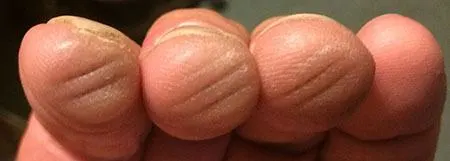Most of the questions we receive usually reveal a gap in our content and today’s question was no different. What we did manage to do this time was publish a full length post related to the growth of calloused guitar fingers before we managed to post the Q&A itself.
If you want the long explanation, you can find that here: How to Build Guitar Calluses. Otherwise, the short and sweet of it can be found below.

I’d like to give a special thanks to David, who caught an error in our Guitar Strings Guide where we managed to invert the order of string gauges in relation to their names. It’s much appreciated because try as we might, errors still slip through. Please never hesitate to correct or to send in a question!
How Long Does it Take to Develop Calloused Guitar Fingers?
Question:
I’ve just started learning how to play guitar in the past few days. My fingertips are like mince meat from pressing on the strings. How long will I have to deal with this before I start to grow guitar calluses? Is there anything I can do to get calloused any faster?
Thanks for your time,
John
Answer:
John, thanks for taking the time to let us know you’re reading and working towards being a better musician. You have a good couple of questions here, but a better way to look at it is how to not delay the development of calluses.
Consistence and repetition are the two key factors. Breaking the pattern in either one of those can make growing calluses take longer than it has to.
To be direct, if you stick to the plan and put in your practice time, you should have full-blown calluses in a month’s time. What I mean by that is you’ll have thick enough pads on the tips of your fingers to not notice any problematic pain any more. They’ll still get thicker and wider past that point, but you should be good to go at that point.
What to do
You can expect the process to look something like this:
- The First Week: You fingers are going to hurt really bad. Try to practice at least 15 minutes per day, but not too much more than that. It’s even better if you can do four or five 5 minute sessions instead of one long stretch.
- The Second Week: The deep throbs and the sharp cutting pain will both be drastically reduced, but you’ll still feel some uncomfortable sensations since you’re still smashing the strings down to your bones. You should visually see some changes to your fingertips too. You can increase your practice time some, but be kind to your hands.
- After One Month: By this point you may have even forgotten about the issue and can practice as much as you’d like. You may notice some skin flaking and peeling off as the calluses you’ve developed make their way to the top of the skin. Don’t pick at them, just let it all happen naturally.
Besides the points mentioned in the timeline above, there are some things you can do to hasten the process. You can use heavier steel strings that will be more abrasive on your fingers, you can rub and mush your fingertips against hard and rough surfaces while not playing to help harden the skin, and you can even try to dry the skin out using rubbing alcohol.

What Not to do
There are things not to do, too. These include not peeling baby calluses off and not playing guitar after having had your hands soaking in water as to avoid ripping off your pads.
If this starts to happen, you can use super glue to help repair them. They’ll become stronger and stronger as you begin to work towards widening them over the entire surface of your finger tips.
And that’s the main point. You need to be purposeful and meticulous in your practice and care of your fingers to make sure you have thick and wide pads that will protect you as you play.
If you do it right (which really means avoiding doing the wrong things and just practicing regularly), it’ll take about a month for you to grow calloused guitar fingers.
Thanks for reaching out. Please let us know how your callouses are coming along,
Jared